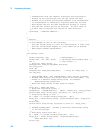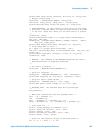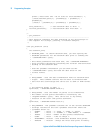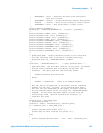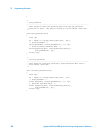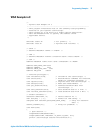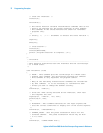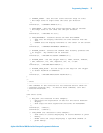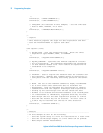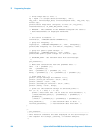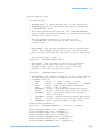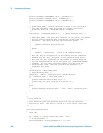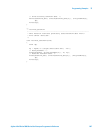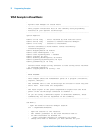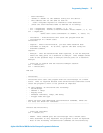562 Agilent InfiniiVision 5000 Series Oscilloscopes Programmer's Reference
9 Programming Examples
*/
viPrintf(vi, ":BLANK CHANNEL1\n");
viPrintf(vi, ":VIEW CHANNEL1\n");
/* TIME_MODE (not executed in this example) - Set the time base
* mode to MAIN, DELAYED, XY or ROLL.
*/
viPrintf(vi, ":TIMEBASE:MODE MAIN\n");
}
/*
* capture
* ------------------------------------------------------------------
* This function prepares the scope for data acquisition and then
* uses the DIGITIZE MACRO to capture some data.
*/
void capture (void)
{
/* AQUIRE_TYPE - Sets the acquisition mode. There are three
* acquisition types NORMAL, PEAK, or AVERAGE.
*/
viPrintf(vi, ":ACQUIRE:TYPE NORMAL\n");
/* AQUIRE_COMPLETE - Specifies the minimum completion criteria
* for an acquisition. The parameter determines the percentage
* of time buckets needed to be "full" before an acquisition is
* considered to be complete.
*/
viPrintf(vi, ":ACQUIRE:COMPLETE 100\n");
/* DIGITIZE - Used to acquire the waveform data for transfer over
* the interface. Sending this command causes an acquisition to
* take place with the resulting data being placed in the buffer.
*/
/* NOTE! The use of the DIGITIZE command is highly recommended
* as it will ensure that sufficient data is available for
* measurement. Keep in mind when the oscilloscope is running,
* communication with the computer interrupts data acquisition.
* Setting up the oscilloscope over the bus causes the data
* buffers to be cleared and internal hardware to be reconfigured.
* If a measurement is immediately requested there may not have
* been enough time for the data acquisition process to collect
* data and the results may not be accurate. An error value of
* 9.9E+37 may be returned over the bus in this situation.
*/
viPrintf(vi, ":DIGITIZE CHAN1\n");
}
/*
* analyze
* ------------------------------------------------------------------
* In this example we will do the following:
* - Save the system setup to a file for restoration at a later time.
* - Save the oscilloscope display to a file which can be printed.
* - Make single channel measurements.



